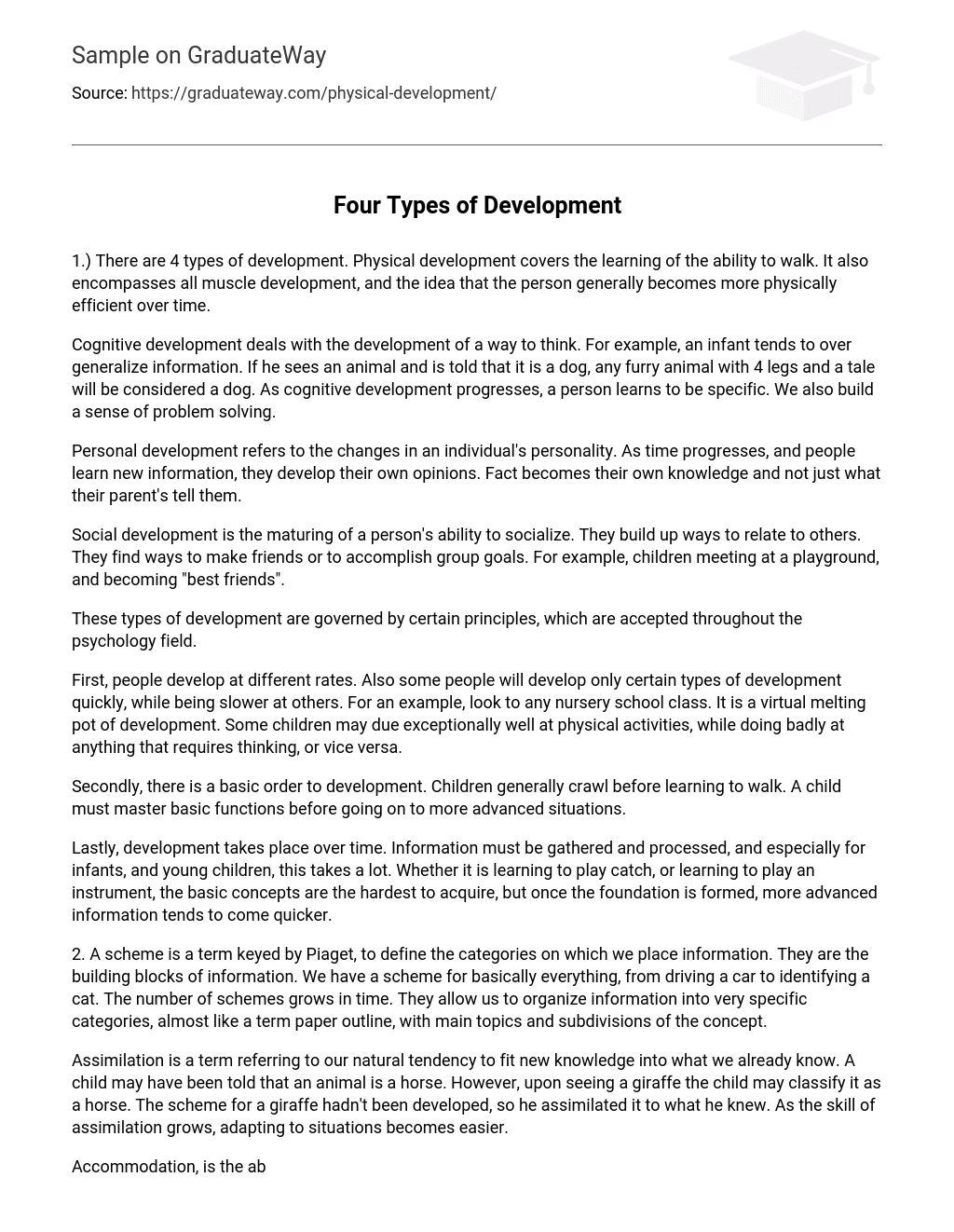1.) There are four types different types of development. One type is physical development, which involves the learning to walk and the growth of muscles. It also includes the concept that individuals become more physically efficient as they age.
Cognitive development refers to the growth of thinking abilities. At first, babies often label any furry, four-legged, tailed animal as a dog if they have been told so. However, as cognitive development progresses, individuals become more precise in their thinking. Additionally, problem-solving skills are nurtured during this advancement.
Personal development entails individuals enhancing their character by gaining new knowledge and nurturing their own viewpoints, instead of solely depending on parental guidance.
Social development involves enhancing an individual’s ability to engage with others, establishing connections and engaging in interpersonal relationships. This encompasses forming friendships and working together towards shared goals. A prime example of this occurs when children meet at a playground and forge a strong bond through play.
The types of development are governed by these principles, which are universally accepted in the field of psychology.
Individuals progress at varying rates and may excel in specific areas while displaying slower progression in others. This diversity is evident in nursery school settings, where children demonstrate a wide range of developmental abilities. For instance, certain children may thrive in physical activities but face challenges when it comes to cognitive tasks, or vice versa.
Additionally, the development process follows a specific sequence. Usually, children begin by crawling and then advance to walking. They need to successfully acquire basic skills before moving on to more intricate situations.
Development occurs gradually over time. It entails collecting and assimilating information, which is particularly challenging for infants and young children. Whether it involves acquiring skills like playing catch or learning to play a musical instrument, mastering fundamental concepts is the most difficult part. However, once the groundwork is established, mastery of more complex information tends to accelerate.
2. A scheme, as defined by Piaget, refers to the categorization of information. Schemes serve as the foundation for organizing information, much like the building blocks of knowledge. They encompass various aspects of our lives, ranging from how to drive a car to recognizing a cat. Over time, the number of schemes expands, enabling us to classify information into highly specific categories, resembling the structure of a term paper with its main topics and concept subdivisions.
Assimilation is the act of integrating fresh information into our current comprehension. For instance, if a child who has learned that an animal is a horse comes across a giraffe, they might mistakenly label it as a horse. This happens because the child hasn’t formed a mental structure to comprehend giraffes and thus assimilates the new knowledge to align with their existing understanding. As individuals become more adept at assimilation, they enhance their ability to adapt to unfamiliar circumstances.
Accommodation is the act of adjusting existing schemes to fit new information. This adjustment happens when assimilation becomes challenging and individuals must reorganize their knowledge. For instance, a child who is used to drinking from a bottle by simply tilting it upwards may spill when trying to drink from a cup. To effectively drink from a cup, the child must change their drinking method and accommodate the cup’s unique features. Embracing this alteration allows the child to adapt to the new way of drinking.
Piaget’s theory suggests that the development of information involves various processes such as organization and assimilation, which can be compared to a “balancing act.” When a person’s existing mental framework (or schema) is suitable for a particular situation and successfully solves problems, they experience a state of equilibrium and comfort.
When faced with a scheme that is unsuccessful, we actively seek a solution because it throws us off balance. This continuous process of trial and error allows us to create new schemes, enabling us to adapt and organize more rapidly.
3. Piaget’s initial cognitive development stage is the sensorimotor phase. This phase (ages 0-2) involves a child exploring through their 5 senses. A key achievement is the capability to regulate their actions, or actions aimed at a specific goal. Movements start to coordinate themselves to achieve particular results, such as placing toys into a container.
The second stage is called the “pre operational” stage, which occurs between the ages of 2 and 5. During this time, children start to comprehend language and make logical connections. They also start using symbols or miming to represent specific events, which is a significant milestone in their development.
The concrete operational stage is the third stage of development. During this stage, children can problem solve and classify objects. They are able to arrange items in order from largest to smallest, a skill called seriation. Additionally, children in this stage can connect and relate different ideas to each other.
The final stage of cognitive development is known as formal operations. During this stage, thinking becomes more systematic and goal-oriented. Children are able to think abstractly and consider hypothetical questions. They can also solve problems using logical reasoning, making subjects like algebra teachable.
4. According to Vygotsky, the concept of the “zone of proximal development” refers to a child’s learning area that cannot be achieved without external assistance. Parents often provide knowledge to a child in order to help them understand a situation. Over time, the amount of additional information or “scaffolding” typically reduces.





